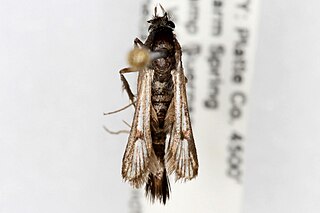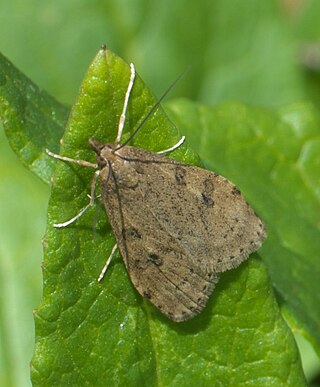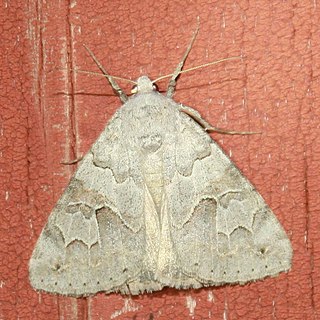
The large yellow underwing is a moth, the type species for the family Noctuidae. It is an abundant species throughout the Palearctic realm, one of the most common and most familiar moths of the region. In some years the species is highly migratory with large numbers appearing suddenly in marginal parts of the range.

Daphne's Greek Cafe or, Daphne's California Greek, is an American fast-casual Greek restaurant operating in California. The restaurant name refers to Daphne of Greek mythology whom the god Apollo desired.
Clancy Edwards is an American retired track and field sprinter. He was considered one of the best sprinters in the world between 1974 and 1978. He won the 200 metres at the 1977 IAAF World Cup, the most important meet of that year, defeating future World Record holder Pietro Mennea.
Gyros is a genus of moths of the family Crambidae.

Litocala is a monotypic moth genus in the family Erebidae. Its only species, Litocala sexsignata, the litocala moth, is found in the United States in Washington, Montana, Utah and Colorado south to southern California and northern Baja California in Mexico. Both the genus and species were first described by Leon F. Harvey, the genus in 1878 and the species three years earlier. The habitat consists of oak woodlands and forests.

Henry Edwards was an English stage actor, writer and entomologist who gained fame in Australia, San Francisco and New York City for his theatre work.

Catocala junctura, the joined underwing or Stretch's underwing, is a moth in the family Erebidae. The species was first described by Francis Walker in 1858. It is found throughout temperate North America, ranging from New York and Pennsylvania west to Montana, Colorado, Oklahoma, Arizona, and into Texas, and north to southern Illinois, extreme southern Alberta and Saskatchewan; it has also been recorded west of the Rocky Mountains from California and south-eastern British Columbia. It is typically found near water, where the food plants of its caterpillar larvae grow plentifully.

Drasteria adumbrata, the shadowy arches, is a moth of the family Erebidae. The species was first described by Hans Hermann Behr in 1870. It is found from coast to coast in southern Canada, south in the west to California and Colorado, south in the east to New England and Michigan. Subspecies D. a. alleni is found from eastern Alberta to New York and Nova Scotia. Subspecies D. a. saxea occurs from southern British Columbia and south-west Alberta south to California and Colorado.

Carmenta verecunda is a moth of the family Sesiidae. It was described by Henry Edwards in 1881, and is known from the United States, including Colorado, Utah, California and Arizona.

Pyramidobela quinquecristata is a moth in the family Oecophoridae. It is found in the mountains around the margins of the Great Basin in North America.

Erechthias lychnopa is a species of moth in the family Tineidae. This species is endemic to New Zealand and has only been collected in a karaka grove at Sinclair Head in Wellington in November. It has yet to be collected again. It has been hypothesised that the larvae inhabit dead wood. It is classified as "Data Deficient" by the Department of Conservation.
Loxostege immerens is a moth in the family Crambidae. It was described by Leon F. Harvey in 1875. It is found in North America, where it has been recorded from California.
Loxostege mojavealis is a moth in the family Crambidae. It was described by Hahn William Capps in 1967. It is found in North America, where it has been recorded from the Mojave Desert in Arizona and California.

Pyrausta comastis is a moth in the family Crambidae. This species is endemic to New Zealand. It has been classified as "nationally vulnerable" by the Department of Conservation.
Gyros atripennalis is a moth in the family Crambidae. It was described by William Barnes and James Halliday McDunnough in 1914. It is found in North America, where it has been recorded in California.

Udea turmalis is a moth in the family Crambidae. It was described by Augustus Radcliffe Grote in 1881. It is found in North America, where it has been recorded from Alberta, Arizona, British Columbia, California, Colorado, Idaho, Manitoba, Montana, Nevada, New Mexico, Utah and Washington.
Drasteria occulta, the occult drasteria moth, is a moth of the family Erebidae. The species was first described by Henry Edwards in 1881. It is found in North America, where it has been recorded from coastal areas in Maine, New Jersey, Pennsylvania and Texas. It is listed as a species of special concern and believed extirpated in the US state of Connecticut.

Drasteria scrupulosa is a moth of the family Erebidae. It is found in North America, where it has been recorded from California, Idaho, Nevada, Oregon and Utah. The habitat consists of open sagebrush steppes.

Agonopterix argillacea is a moth in the family Depressariidae. It was described by Thomas de Grey in 1881. It is found in North America, where it has been recorded from California to British Columbia and in Manitoba, Ontario, New Brunswick, Nova Scotia, Michigan, South Dakota, Illinois, Texas, Florida and Utah.

Hierodoris bilineata is a species of moth in the family Oecophoridae. It is endemic to New Zealand. This species is classified as "At Risk, Naturally Uncommon" by the Department of Conservation. It is possible that this species gives birth to live young rather than lay eggs as is the norm.














